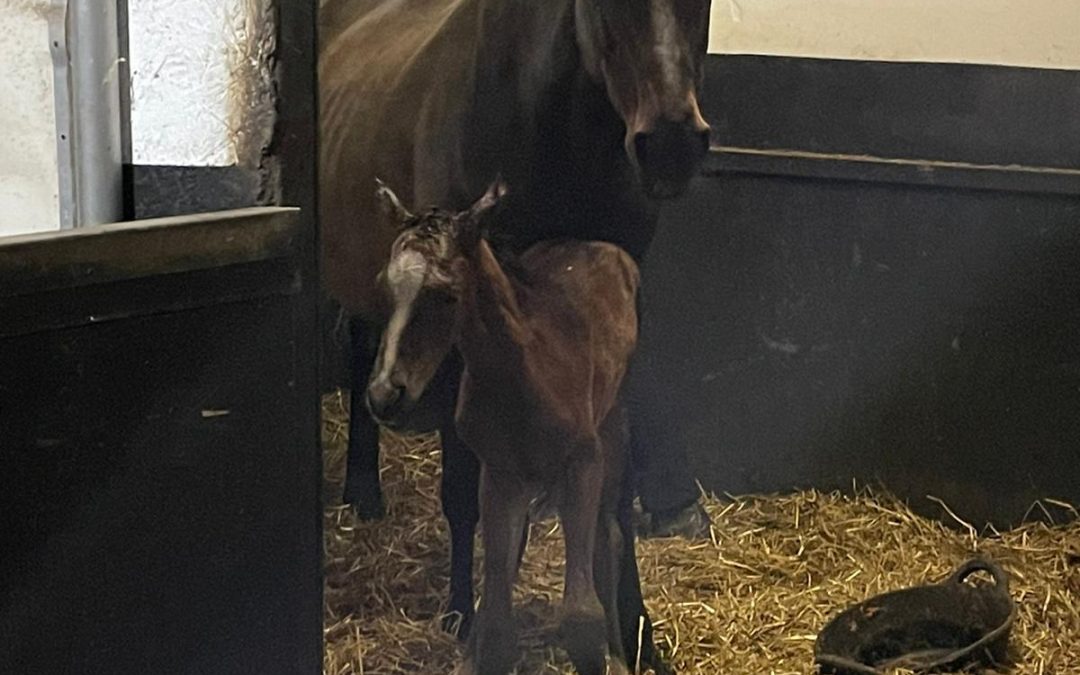We are getting ever closer to foaling season and as a consequence we thought we would do a blog on how to get prepared for this exciting time.
Things to have in your foaling kit:
- Phone number of your vet on speed dial (just in case)
- Iodine/purple spray
- Tail bandage
- Disposable gloves
- Clean bowl or jug to be able to collect colostrum if the foal doesn’t feed
- Spare clean buckets
- Feed that can be soaked (high fibre)
- Head torch
- Towel
- Baling twine or white string to tie up afterbirth before it sheds
Where to foal down:
Mares need a big safe space in which to foal down in. A big stable with solid sides is great for both the mare and foal. Water and hay should be at a height where legs can’t get stuck or foals can’t be trapped against. The bedding used should be straw rather than shavings as this will provide a warm fibre base which is unlikely to get stuck to the foals umbilical etc. Beds should be kept very clean to ensure good biosecurity. The minimum size of stable should be 14 feet by 14 feet.
Signs of labour:
Stage 1:
Foal is getting into position for foaling – mare will seem restless might show signs of mild colic, getting up and down, or pacing the stable or field. This can go on for hours.
Stage 2:
Starts with the passage of the water bag and the breakage of this bag and ends with the delivery of the foal. This stage will involve strong uterine contractions and the mare will be laid down for this stage. All foals are born in the diving position so the first thing you should see if the feet (front ones). The feet should appear sole down, if this is not the case, the foal is either upside down or coming in breach position (bum first). If either of these positions are seen, assistance will be needed to get the foal out. This stage should last a total of 17 mins. If it is any longer then assistance should be sought.
Foaling 1,2,3 – These are the time frames that are important to remember after the mare has foaled down.
- 1: Foal should stand within an hour after birth
- 2: foal should be suckling within two hours after birth. If this doesn’t occur by hour 4 it is vital to get the vet out to help or the foal may not absorb enough antibodies from the first milk. This stops in the first 12 hours.
- 3: Afterbirth should shed within the first 3 hours afterbirth. If it hasn’t this needs to be manually removed by a vet. If it passes naturally then please keep it safe. Your vet will want to examine it, to ensure it is complete.
The foal will have it’s umbilical cord treated to ensure that it dries up and seals. This ensures bacteria from the environment doesn’t enter through the umbilical cord into the foals body to cause serious conditions such as joint or navel ill. This is done by treating the umbilical cord with either blue/purple spray or iodine daily for the first 3 days of life.
Post foaling vet check: This should be done 12-18 hours after the foal has been born.
It is important to get the mare and foal checked post foaling even if it has been a text book birth. Mares who’s vaccinations are not up to date should be given Tetanus antitoxin alongside their foals. This will cover both of them for 6 weeks, as if the mare is not vaccinated then she will have no antibodies in her first milk to give to the foal.
Vet should check the foal has no cleft palate or wry nose, that it has no issues such as abdominal hernias, if joint issues due to positioning. They will want to know that the first faecal motion (meconium) has been passed and that foal is drinking and urinating. Foals in the first few days will feed every hour for a couple of minutes at a time.
If in doubt it is better to talk to your vet early in the process rather than leaving it for any length of time. Foals are fragile newborns and should be handled with care.

